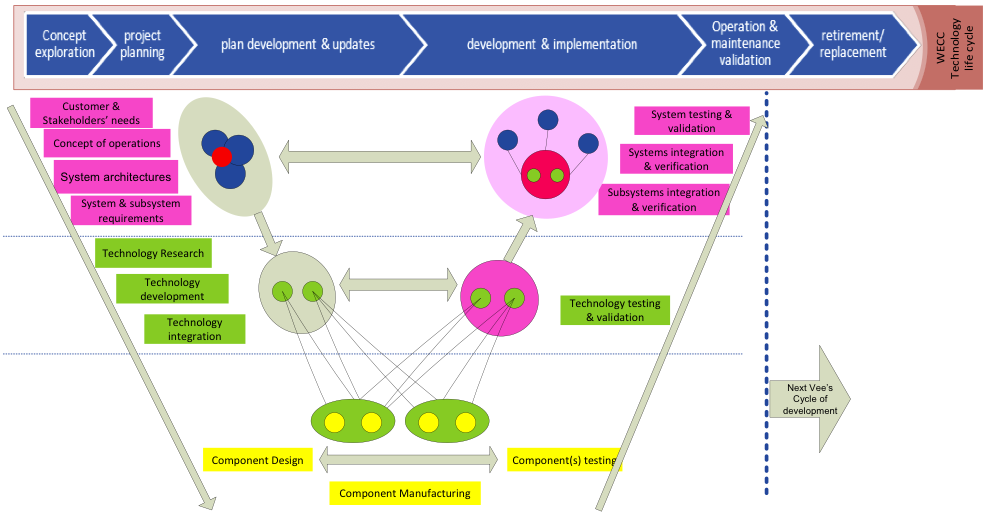A Retrospective Overview Of Wind Farms In Cold Climate Regions
Challenges Of Cost Effectiveness
Wind energy in cold climate regions (WECC) stands at the threshold of major research and development trends within onshore & offshore wind energy. It is actively seeking to harness the assets that its emerging and incremental research efforts afford it. Cold climate wind farms have shifted from being ordinary onshore wind farms to exemplary models those are demanding advanced research & development, cross-disciplinary, safer and competitive cold climate technology.
The availability measurements and performance estimations show remarkable losses share due to cold climate effects where ice is the most critical one. for Nordic sites, Ronsten (2009) showed that icing could have an impact with 6.1% on total wind energy production. Also, El-Thalji and Liyanage (2011) investigated the main environmental disturbance on an onshore wind farm that is located in a cold climate area directly facing the sea. The study presented an influence diagram of environmental disturbance on physical asset, such as excessive wind, transient wind direction, ice, low temperature, and darkness. However, there are already several installed or projected wind parks in cold climate regions: northern and central Europe, northern America and Asia, in total approximately about 500 MW.
|
Furthermore, the operation and maintenance issues are also significant in this context. Laakso et al. (2003) showed that the O&M had practical constraints due to the location of turbines in remote sites. The accessibility to
|
“The Accessibility To Such Remote Sites In The Winter Has Difficulties, Or Even Impossible Time Windows.” |
such remote sites in the winter has difficulties, or even impossible time windows. The working conditions like humidity, extreme wind speed, snow and icing may make maintenance operations more difficult and time-consuming during winter time. Moreover, Laakso (2005) presented the recent observations about the overhaul and maintenance in cold climates. These reports show that the lubricants, rubber seals and mechanical properties of materials are all affected by cold air temperatures, and mainly, blade pitch change mechanism in variable pitch turbines, yaw drive mechanism and gearbox are imposed to supplemental stresses.
Thus, it is worth to ask about ‘How can technological development provide survivable and cost effective solutions over the expected lifetime for wind farms in cold climate sites?’ cost effectiveness and life time are most significant issues behind the rapid technology development within this sector. What is the current state-of-the-art? And how far it is from operational excellence?
Therefore, the article offers an introduction to research & development practices of cold climate technology. Based on that, the article tries to outline how cold climate technologies of wind energy application can gain its full potential as cost effective technology.
WECC Technology’s State-Of-The-Art
The main impacts within cold climate sites are related to health & safety, loss of production, increase loads, increase noise and unbalanced of rotor blades and drive-train oscillations. Therefore, the main challenges are related to transportation, installation operations, foundation and support structures and operation and maintenance practices, however, the most critical ones are icing events and their anti/de-icing solutions. Moreover, the minimum requirements for wind turbines in cold climate regions are partially specified and recommended such as low temperature steel and sensors, increased isolation, component survival, heating of hydraulic oil and lubricant and safety issues.
“One Of The Hottest Topics Is The Ice-Related Technology, Where There Are Around Five Different Solutions; Hot Air, Coating Paint, Capable Blade Control System, Built-On Or Integrated Heating Panels, And Geometrical-Enabled Blade.” |
The current research and development efforts within wind energy in cold climate regions can be classified into five main categories; physics of icing (i.e. adhesion), icing mapping, ‘effectiveness and impact’ analysis, ice-related technology (i.e. ice detection, de-icing, and anti-icing) and design for safety.
|
Effectiveness and impact analysis is mainly concerned about outputs, loads, acoustic noise emissions, etc. several models, techniques and technological solutions have rapidly developed and commercialized in order to cope with operational challenges. One of the hottest topics is the ice-related technology, where there are around five different solutions; hot air, coating paint, capable blade control system, built-on or integrated heating panels, and geometrical-enabled blade. This brief state-of-the-art shows clearly the incredible and rapid development that is going on within research committees and industrial development groups toward enhancing the cost effectiveness of cold climate wind energy sector.
Systemic Depth Of Technology Development
However, from business point of view, the wind farm operators they do buy a system rather than a technology and they do expect the system to satisfy their expectations under the actual site conditions. Therefore, some key acceptance criteria are always discussed within evaluation process of technological system for WECC purposes; anti-icing capability, de-icing capability (incubation and recovery time), ice-detectability, time to de-ice, scalability and scale-related cost, power consumptions, integrity to other control system, remoteness, etc. the assessment and evaluation process based on such criteria are still fuzzy and complex. Evaluation process is still done by operators or operating companies based on some physical prototypes. Unfortunately, those cross-disciplinary technologies-that have been developed- bring also some multi-disciplinary pitfalls during the operation phase. Simply, in order to understand the cross-disciplinary technology term, it is work to have a look into figure below where the life cycle of wind farm are illustrated with an internal operation and maintenance lifecycle as well. Each life cycle has a number of processes (blocks in figure) and associated industrial stakeholders. Furthermore, the developed technologies are allocated as technological systems in those processes. Each of those processes has more than one use-case scenarios and there is variation between different stakeholders. The use-case scenario represents the actions that are required to enable or abandon a goal such as using, operating, maintaining, replacing, etc. the linking point between use-case scenario and technology development is based on the fact that designers do extract their system requirements- which are going to be defined as functions and allocated as physical components- basically from use-case scenarios. In other word, if a designer partially/totally misses one of use-case scenarios, then the technological system will be not able to perform specific functions. For example, eagle created to be a professional sky hunter, however, since the scenario of swimming do not exist, it can’t simply swim.
The main problem is that such pitfalls are often discovered only at a later stage of the design through the physical prototypes and in particular under in-site testing. Moreover, these pitfalls might have different activating factors under specific operating conditions. In return, that might not satisfy the operators who do the evaluation step. In this sense, the industrial practitioners are somehow looking into the upper level of development (please see figure below) where the do like to see valid outcomes of specific Technology in full system scale. The researcher and development group are deeply focused on technology level of development. To illustrate these two points of view, please see Figure below where three levels of development are presented; system (top), technology (middle) and component (bottom). The technology development requires more robust approach to highlight the potential cross-disciplinary pitfalls. Thus, it is always an issue whether the technology development goes little bit in depth during system level of development phase and keep continuous iterative process between two levels of development. This type of development activities could reveal the systemic depth and its related pitfalls. Systemic depth concept states that “the technology’s value in industrial applications is predicated on its life cycle, system context and use-case scenarios depth”.
In the end, it is clear that the historical research & development efforts and the industrial experiences highlight the need of what is known as “systemic depth”. The operation and maintenance performance might reach excellence as expected due to systemic depth considerations. Moreover, the verification and validation of system development might be more effective to detect cross-disciplinary pitfalls as long as the systemic depth is reveled. The concept of systemic depth for technology development in wind energy sector is observed in order to let the industrial development harness the full potential of research efforts. Systemic depth is required to enhance the cost effectiveness over the expected lifetime of a product and enhance the lifetime of technology as well.
This is a guest post from one of our expert partners.
About The Author
|
Mr. El-Thalji has more than 6 years’ experience in O&M of wind energy sector and is the author more than 20 scientific publications. he is currently research scientist of Life time reliability solutions in VTT technical research Centre of Finland. Mr. El-Thalji has BSc in industrial Engineering, MSc of Maintenance engineering and Licentiate of technology in Dependability Engineering. Mr. El-Thalji worked as researcher in Linnaeus university, Centre of industrial asset management (CIAM, Norway), and currently in VTT Finland, mainly, for the wind power industry and worked with projects such as Vindforsk III, NORCOWE and AERTOs. His current research is focused on predictive health monitoring systems and the cost effectiveness assessment, both from systems engineering perspective.
|


